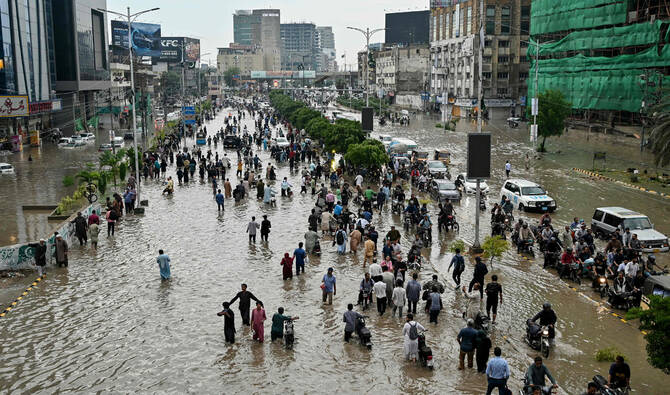Karachi, Pakistan’s bustling metropolis and economic hub, has once again found itself submerged under water after unprecedented monsoon rains battered the city. In just 24 hours, torrential downpours broke a 46-year rainfall record, turning roads into rivers, paralyzing daily life, and exposing the city’s fragile infrastructure.
According to the Pakistan Meteorological Department, Karachi’s airport area received 163.5 millimeters of rain, the heaviest since 1979. In the city’s northeast, rainfall touched 178 millimeters, setting a new local record. The sheer volume of water overwhelmed Karachi’s outdated drainage system, leading to widespread flooding across residential and commercial zones.
A City Brought to a Standstill
As the rains poured, major thoroughfares like Shahrah-e-Faisal and University Road were submerged, trapping vehicles for hours. Many commuters abandoned cars and motorbikes mid-road to wade through waist-deep water. Public transport collapsed, with buses, rickshaws, and ride-hailing services grinding to a halt.
Authorities announced a citywide public holiday, shutting down schools, offices, and banks to minimize risk. But for Karachi’s working class, particularly daily wage earners, the day off meant lost income at a time when inflation is already pinching household budgets.
Power and Communication Outages
The heavy downpour triggered widespread power outages, with the K-Electric grid collapsing in several areas. Citizens reported being without electricity for over 24 hours in neighborhoods like Korangi, Gulshan, and Malir.
Internet and mobile phone networks also suffered disruptions as telecom towers lost connectivity. For a city that drives much of Pakistan’s digital economy, including freelancing and e-commerce, the blackout had significant financial consequences.
Public Outcry and Mismanagement
Karachiites have once again voiced frustration over what they see as poor governance and lack of planning. Social media was filled with images of collapsed roads, overflowing sewers, and people stranded on rooftops. Many questioned why the city, despite facing similar floods every monsoon season, still lacks a modern drainage and flood management system.
Urban planners argue that rapid unplanned construction, shrinking natural waterways, and insufficient investment in storm drains have made Karachi increasingly vulnerable. Climate activists also warn that extreme weather events are becoming more frequent due to global climate change, and without adaptation policies, such disasters will only worsen.
Government and Relief Response
Rescue teams, including the Pakistan Navy and Rangers, were deployed to evacuate stranded families. The Sindh government set up temporary relief camps in schools and community centers. However, many residents complained that help arrived late, and relief supplies were inadequate.
Prime Minister Shehbaz Sharif expressed solidarity with Karachi’s citizens, pledging federal support for relief operations. But critics argue that without long-term investment in infrastructure, such pledges will remain temporary fixes.
A Climate Wake-Up Call
The Karachi floods of 2025 are more than just a natural disaster—they are a wake-up call. As Pakistan remains among the top 10 countries most vulnerable to climate change, urban centers like Karachi need resilient infrastructure, flood forecasting systems, and sustainable urban planning.
Until then, the city’s residents will continue to face the same nightmare every monsoon: a metropolis drowned by its own neglect.
